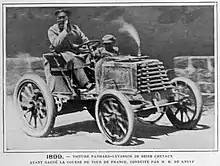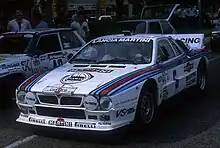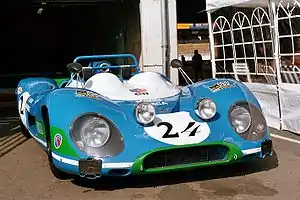Tour de France Automobile
Tour de France Automobile was a sports car race held on roads around France regularly (mostly annually) between 1899 and 1986.



History
The first edition in 1899 was won by René de Knyff driving a Panhard et Levassor at 30 mph (50 km/h). Organized by Le Matin, under the control of the Automobile Club de France, held July 16 to 24, in seven stages: Paris-Nancy; Nancy-Aix-les-Bains; Aix-les-Bains-Vichy; Vichy-Périgueux; Périgueux-Nantes; Nantes-Cabourg; Cabourg-Paris. Out of 49 starters, 21 vehicles finished.[1] The 1908 event was won by Clément-Bayard.[2]
1950s revival
The first event after the war took place in 1951, organised by the Automobile Club de Nice, and was won by Pierre Boncompagni "Pagnibon"/Barracquet in a 2.6-litre Ferrari 212 Export.[3] The event visited the La Turbie Hill Climb, near Nice.
The 1954 event was won by the 2.5 litre Gordini of Jacques Pollet and M. Gauthier, on the traditional Nice to Nice route.[4]
Scuderia Ferrari won eight times between 1951 and 1962. After the triumph of Alfonso de Portago in 1956, Olivier Gendebien won with partner Lucien Bianchi three times in a row (1957, 1958 and 1959).
The 1956 event was won by de Portago/Nelson in a Ferrari 250 2.9 with Moss/Houel (Mercedes 300 SL) in second place.[5]
In 1958 the British racing driver Peter Whitehead had a fatal accident on the tour driving a Jaguar with his half-brother Graham Whitehead, who was considered a reliable co-pilot in long-distance races. On September 21, 1958, after dark, Graham was driving when the car broke through a rotten bridge railing in Lasalle, Gard, near Nimes, and crashed into a ravine.
1960s

In the 1960s, French racing and rally driver Bernard Consten (fr: Bernard Consten) won the race five times, making it the record winner to this day. In the same decade, the stage race was also opened to sports prototypes, so that racing cars like the Ferrari 512 S, the Ford GT40 or the Matra MS650 drove hundreds of kilometres on public roads.
The 1960 Tour de France took place between September 15 and 23 that year. Starting at Nice it visited Mont Ventoux, Nurburgring, Spa, Montlhéry, Rouen and Le Mans with the finish at Clermont Ferrand. The event was won overall by the Ferrari 250 G.T. of Willy Mairesse/Georges Berger. The Jaguar 3.8 litre Mk. II of Bernard Consten/J. Renel won the Touring category with the BMW 700 coupé of Metternich/Hohenlohe winning the Index of Performance.[6]
Willy Mairesse won again in 1961 together with Georges Berger.
The last Ferrari victory was in 1964 with Lucien Bianchi/Georges Berger driving a Ferrari 250 GTO, entered by Ecurie Nationale Belge.[7] The event started at Lille, visiting Reims, Rouen, Le Mans, Clermont-Ferrand, Monza and Pau. The Touring car category was won by Peter Procter/Andrew Cowan in a Ford Mustang,[8] entered by Alan Mann Racing.[9] The A.C. Shelby Cobras of Maurice Trintignant, Bob Bondurant and André Simon all retired.
1980s
The 1980s saw the event incorporated into the European Rally Championship which saw an influx of new competitors. The last event was held in 1986.
Historic race
The event was revived in 1992 for historic cars, now known as the Tour Auto. It is held in April and features both a competition and a regularity class. The format is a 5-day event combining about 2,500 km of roads, 4 or 5 circuit races and 6 to 8 hillclimbs. The start is always in Paris, whereas the finish alternates between various southern seaside towns like Biarritz, Cannes and Nice. Patrick Peter of Agence Peter is the organiser.
The winning cars over the years (since 1996 only pre '66 cars can win overall, even though cars up to 1974 are allowed) include the Ford Shelby Mustang 350GT, Ford GT40, AC Cobra 289, Lotus Elan, Ferrari Daytona Gr IV. Drivers who won the competition class include Jürgen Barth, Henri Pescarolo and Walter Röhrl.
Competitors
Previous winners of the original Tour de France Automobile who have participated in the Historic Tour Auto include JC Andruet, Jean Ragnotti, Bernard Consten, Gérard Larousse, Johnny Rives.
Other famous entrants since 1992 were: Stirling Moss, Danny Sullivan, Phil Hill, Ari Vatanen, Emanuele Pirro, Eric Comas, Bobby Rahal, Rob Walton, Walter Röhrl, Jürgen Barth, Yannick Dalmas, Thierry Boutsen, Romain Dumas, Nick Mason, Olivier Panis.
Dutch racing driver Hans Hugenholtz won the competition class of the Patrick Peter organised event 7 times (1993-1999-2000-2001-2004-2006-2007), more than any other entrant, with a Ferrari Daytona Gr. IV, Shelby Mustang 350GT, Ford GT40 (twice) and a Lotus Elan (3 times).
Winners 1951–1986
See also
References
- International Motor Cyclopaedia, Year Book-March 1908 to March 1909, Pages 114–115, Publisher: E.E. Schwarzkopf, New York.
- Hydro Retro, Clement-Bayard, pdf (French) Clément-Bayard, sans peur et sans reproche par Gérard Hartmann
- The Motor Year Book 1952, Temple Press, Page 196.
- The Autocar, September 17, 1954, Pages 401–402; The Autocar, September 24, 1954, Pages 426–427; Motor Sport, October 1954, Pages 557–558.
- The Motor Year Book 1957, Temple Press, Page 197.
- Motor Sport, August 1960, Page 627; Motor Sport, November 1960, Page 904.
- Motor Sport, November 1964, Pages 949, 956.
- Motor Sport, November 1964, Page 948.
- For a road test of the Ford Mustang, DPK5B, which Bo Ljungfeldt drove in this event see: Motor Sport, December 1964, Pages 1013–1014.
- Motor, October 3, 1970, Page 70.